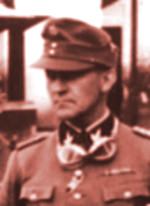 |
Jürgen Stroop was born on 26 September 1892 in Detmold (Germany). His father was a policeman. After receiving
a basic school education, he became an apprentice with the land register in his home town, where he worked until
the start of WW 1, when he joined the Reichswehr as a volunteer. At the end of the war, he held the rank
of a Vizefeldwebel (vice staff sergeant). After the war, he returned to work at the land register.
Stroop joined both the SS and the NSDAP in 1932. During the German
election campaign of 1932 Hitler, Heinrich Himmler, and Göring became aware of him. In 1933,
he was appointed leader of the state Hilfspolizei (auxiliary police) in the German state of Lippe.
One year later, he was promoted from the rank of SS-Oberscharführer to the rank of
SS-Hauptsturmführer. Subsequently he worked for the SS-administration in
Münster and Hamburg. In autumn 1938, he was promoted to SS-Standartenführer.
After the invasion of Poland, he served as commander of the SS-section in Gniezno (today Poland). In May 1941,
he changed his name from Josef to Jürgen for ideological reasons and in remembrence of his late son.
In April 1943, Himmler replaced the chief of the SS and police in the Warsaw district, SS-Obergruppenführer
Ferdinand von Sammern-Frankenegg, with Stroop (as SSPF Warschau). A veteran of
WW 1, Stroop had more recently been involved in operations against Soviet partisans in the Ukraine
and was familiar with the latest techniques in counterguerrilla warfare.
Stroop was responsible for crushing the rebellion in the Warsaw Ghetto (19 April - 16 May 1943).
The operation commenced at 06:00 hrs on 19 April; Stroop assumed command at 08:00 hrs on the same day.
As the German forces were forced back by heavy Jewish resistance, he ordered the entire ghetto burned down.
Afterwards, in his famous report to his superior, SS-Obergruppenführer
F.W. Krüger, and Himmler, Stroop boasted that "the Jewish Quarter of Warsaw is no more".
For leading the German troops in the Warsaw Ghetto Uprising Stroop was decorated with the Iron Cross 1st class.
His report was done in triplicate: one for Himmler, one for Krüger, and one for himself. It contained
a summary about the Aktion, the sent telexes,
and a collection of photos which have been taken in the ghetto during the fights.
After the war one report was confiscated by U.S. troops. Later it played a major role in the
Nürnberg Trials. Stroop never denied the authenticity of the found version.
From September - November 1943, Stroop was SS- and Police Chief in Greece,
then served in the Rhein (Rhine) area until end of war. U.S. troops captured him on 8 May 1945.
A U.S. military tribunal in Dachau sentenced him to death on 21 March 1947. The sentence was not executed
and Stroop was extradited to Poland. There he was sentenced to death again on 23 July 1951. Stroop was hanged on
6 March 1952 in Warsaw.
ARC Main Page
Warsaw Ghetto Uprising
Photos: Institute of National Remembrance Warszawa, and USHMM
Translations based on: A Teacher's Guide to the Holocaust
© ARC 2006




